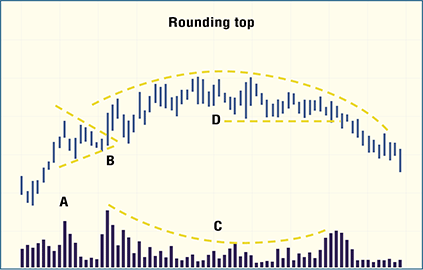Novice Traders’ Notebook
Cardinal Reversal Patterns — At Tops
3. The Rounding Top
The rounding top reflects the market’s perception that the underlying fundamentals driving the prices are changing, but the turn is markedly slow. Often, the first sign that the market is near the end of the uptrend is a climatic level of volume (A). However, the news is still very positive, which brings in new buyers. At this point, the market will begin to consolidate the recent gains (B). This corrective process can take on many forms, but the key issue is that the volume will recede as the consolidation unfolds. This lack of volume indicates that the uptrend is still intact, as there is a lack of profit-taking.

It is at this point that the market will begin to advance, but the high volume seen in the recent rallies is absent. There is a continued trend of increased volume during the advances and lighter volume during the sideways price action, but with each advance, there will be less and less volume. The volume chart (C) will often be a mirror image of the price action. New price peaks are accompanied with lower peaks in volume. At some point, the market peaks and begins to falter. As the market begins to roll over, there should be a support line established under the last consolidation (D). The break of this trendline, with heavy volume, is the signal that the rounding top is complete.